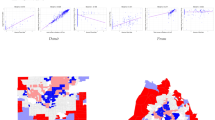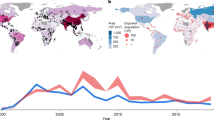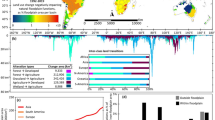Abstract
Rapid urbanization is leading to the expansion of human settlements in flood-prone areas, and the impact is not uniform across different communities. Few studies have comprehensively investigated the flood exposure faced by vulnerable communities in the Global South, where pervasive slums present a major challenge to inclusive urban planning and flood management. Here, combining advanced machine learning techniques and publicly available satellite images, we identify hot spots of urban slum populations in floodplains in the Global South and examine their settlement patterns. We find that approximately one in three people living in slums in the Global South resides in a floodplain. Slum dwellers are 32% more likely to settle in floodplains compared with residents in adequate housing. The concentration of slum populations is particularly high in areas that have experienced severe floods. These data-driven insights highlight the disproportionate flood exposure faced by slum dwellers in the Global South and underscore the need for just and equitable flood adaptation management.
This is a preview of subscription content, access via your institution
Access options
Subscribe to this journal
Receive 12 digital issues and online access to articles
118,99 € per year
only 9,92 € per issue
Buy this article
- Purchase on SpringerLink
- Instant access to full article PDF
Prices may be subject to local taxes which are calculated during checkout





Similar content being viewed by others
Data availability
All household-based data are available to download free of charge by registered users from the DHS program (https://www.dhsprogram.com/data/). Satellite images and land cover layer products can be accessed via the GEE platform (https://earthengine.google.com/), specifically including the Landsat images (https://developers.google.com/earth-engine/datasets/catalog/LANDSAT_LC08_C02_T1_L2, https://developers.google.com/earth-engine/datasets/catalog/LANDSAT_LE07_C02_T1_L2), and the Copernicus Global Land Cover Layers (https://developers.google.com/earth-engine/datasets/catalog/COPERNICUS_Landcover_100m_Proba-V-C3_Global). The Global NPP-VIIRS-like nighttime light dataset is from the Harvard Dataverse (https://doi.org/10.7910/DVN/YGIVCD). The Settlement Model grid (GHS-SMOD) and Population Grid (GHS-POP) can be obtained from the Global Human Settlement Layer (https://ghsl.jrc.ec.europa.eu/download.php). The Emergency Events Database (EM-DAT) records and their geocoded extension are obtained from the Centre for Research on the Epidemiology of Disasters (https://www.emdat.be/) and the Socioeconomic Data and Applications Center (https://sedac.ciesin.columbia.edu/data/set/pend-gdis-1960-2018). The administrative boundary data used in this study are publicly available from the GADM database (https://gadm.org/).
Code availability
Codes for reproducibility of the findings are available via Zenodo at https://doi.org/10.5281/zenodo.14790692 (ref. 84).
References
UN Office for Disaster Risk Reduction. Human Cost of Disasters: An Overview of the Last 20 Years (2000–2019) (United Nations, 2020).
Jongman, B. et al. Declining vulnerability to river floods and the global benefits of adaptation. Proc. Natl Acad. Sci. USA 112, E2271–E2280 (2015).
Winsemius, H. C. et al. Global drivers of future river flood risk. Nat. Clim. Change 6, 381–385 (2016).
Rentschler, J. et al. Global evidence of rapid urban growth in flood zones since 1985. Nature 622, 87–92 (2023).
Robinson, M. & Shine, T. Achieving a climate justice pathway to 1.5 °C. Nat. Clim. Change 8, 564–569 (2018).
Al-Humaiqani, M. M. & Al-Ghamdi, S. G. The built environment resilience qualities to climate change impact: Concepts, frameworks, and directions for future research. Sustain. Cities Soc. 80, 103797 (2022).
Collado, J. R. N. & Wang, H.-H. Slum upgrading and climate change adaptation and mitigation: lessons from Latin America. Cities 104, 102791 (2020).
Woo, B. & Jun, H.-J. Globalization and slums: how do economic, political, and social globalization affect slum prevalence? Habitat Int. 98, 102152 (2020).
Mård, J., Di Baldassarre, G. & Mazzoleni, M. Nighttime light data reveal how flood protection shapes human proximity to rivers. Sci. Adv. 4, eaar5779 (2018).
Parmesan, C., Morecroft, M. D. & Trisurat, Y. Climate Change 2022: Impacts, Adaptation and Vulnerability (GIEC, 2022).
World Cities Report 2020: The Value of Sustainable Urbanization (UN-Habitat, 2020).
Turley, R., Saith, R., Bhan, N., Rehfuess, E. & Carter, B. Slum upgrading strategies involving physical environment and infrastructure interventions and their effects on health and socio-economic outcomes. Cochrane Database Syst. Rev. 1, CD010067 (2013).
Satterthwaite, D. et al. Building resilience to climate change in informal settlements. One Earth 2, 143–156 (2020).
Stewart, F. The Sustainable Development Goals: a comment. J. Global Ethics 11, 288–293 (2015).
Smythe, I. S. & Blumenstock, J. E. Geographic microtargeting of social assistance with high-resolution poverty maps. Proc. Natl Acad. Sci. USA 119, e2120025119 (2022).
Adshead, D. et al. Climate threats to coastal infrastructure and sustainable development outcomes. Nat. Clim. Change https://doi.org/10.1038/s41558-024-01950-2 (2024).
Hughes, S., Giest, S. & Tozer, L. Accountability and data-driven urban climate governance. Nat. Clim. Change 10, 1085–1090 (2020).
Lilford, R. J. et al. Improving the health and welfare of people who live in slums. Lancet 389, 559–570 (2017).
Waters, J. & Adger, W. N. Spatial, network and temporal dimensions of the determinants of adaptive capacity in poor urban areas. Global Environ. Change 46, 42–49 (2017).
Bukvic, A., Mitchell, A., Shao, Y. & Irish, J. Spatiotemporal implications of flooding on relocation risk in rural and urban coastal municipalities. Land Use Policy 132, 106754 (2023).
Tessler, Z. et al. Profiling risk and sustainability in coastal deltas of the world. Science 349, 638–643 (2015).
Vousdoukas, M. I. et al. Small Island Developing States under threat by rising seas even in a 1.5 °C warming world. Nat. Sustain. 6, 1552–1564 (2023).
Sanders, B. F. et al. Large and inequitable flood risks in Los Angeles, California. Nat. Sustain. 6, 47–57 (2023).
Sakijege, T., Lupala, J. & Sheuya, S. Flooding, flood risks and coping strategies in urban informal residential areas: the case of Keko Machungwa, Dar es Salaam, Tanzania. Jàmbá J. Disast. Risk Stud. 4, 1–10 (2012).
Braun, B. & Aßheuer, T. Floods in megacity environments: vulnerability and coping strategies of slum dwellers in Dhaka/Bangladesh. Nat. Hazards 58, 771–787 (2011).
Owusu, M. et al. Towards user-driven Earth observation-based slum mapping. Comput. Environ. Urban Syst. 89, 101681 (2021).
Ozturk, U. et al. How climate change and unplanned urban sprawl bring more landslides. Nature 608, 262–265 (2022).
Brelsford, C., Martin, T., Hand, J. & Bettencourt, L. M. Toward cities without slums: topology and the spatial evolution of neighborhoods. Sci. Adv. 4, eaar4644 (2018).
Fox, S. The political economy of slums: theory and evidence from Sub-Saharan Africa. World Dev. 54, 191–203 (2014).
Tjia, D. & Coetzee, S. Geospatial information needs for informal settlement upgrading—a review. Habitat Int. 122, 102531 (2022).
Gram-Hansen, B. J. et al. Mapping informal settlements in developing countries using machine learning and low resolution multi-spectral data. In Proc. 2019 AAAI/ACM Conference on AI, Ethics, and Society 361–368 (ACM, 2019).
Ratledge, N., Cadamuro, G., de la Cuesta, B., Stigler, M. & Burke, M. Using machine learning to assess the livelihood impact of electricity access. Nature 611, 491–495 (2022).
MacTavish, R. et al. Identifying deprived “slum” neighbourhoods in the Greater Accra Metropolitan Area of Ghana using census and remote sensing data. World Dev. 167, 106253 (2023).
Mahabir, R., Agouris, P., Stefanidis, A., Croitoru, A. & Crooks, A. T. Detecting and mapping slums using open data: a case study in Kenya. Int. J. Digit. Earth 13, 683–707 (2020).
Li, C. et al. Slum and urban deprivation in compacted and peri-urban neighborhoods in sub-Saharan Africa. Sustain. Cities Soc. 99, 104863 (2023).
Tusting, L. S. et al. Mapping changes in housing in sub-Saharan Africa from 2000 to 2015. Nature 568, 391–394 (2019).
Chi, G., Fang, H., Chatterjee, S. & Blumenstock, J. E. Microestimates of wealth for all low-and middle-income countries. Proc. Natl Acad. Sci. USA 119, e2113658119 (2022).
Jean, N. et al. Combining satellite imagery and machine learning to predict poverty. Science 353, 790–794 (2016).
Adger, W. N., Paavola, J. & Huq, S. Toward Justice in Adaptation to Climate Change (MIT Press, 2006).
Rana, I. A. & Routray, J. K. Integrated methodology for flood risk assessment and application in urban communities of Pakistan. Nat. Hazards 91, 239–266 (2018).
Behrer, A. P. & Heft-Neal, S. Higher air pollution in wealthy districts of most low-and middle-income countries. Nat. Sustain. https://doi.org/10.1038/s41893-023-01254-x (2024).
Andreadis, K. M. et al. Urbanizing the floodplain: global changes of imperviousness in flood-prone areas. Environ. Res. Lett. 17, 104024 (2022).
Berndtsson, R. et al. Drivers of changing urban flood risk: a framework for action. J. Environ. Manag. 240, 47–56 (2019).
Brown-Luthango, M., Reyes, E. & Gubevu, M. Informal settlement upgrading and safety: experiences from Cape Town, South Africa. J. Hous. Built Environ. 32, 471–493 (2017).
Roy, A. Urban informality: toward an epistemology of planning. J. Am. Planning Assoc. 71, 147–158 (2005).
Kovacic, Z. Governing informality through representation: examples from slum policies in Brazil and South Africa. Cities 125, 102122 (2022).
Adger, W. N. Vulnerability. Global Environ. Change 16, 268–281 (2006).
Tesselaar, M., Botzen, W. W., Tiggeloven, T. & Aerts, J. C. Flood insurance is a driver of population growth in European floodplains. Nat. Commun. 14, 7483 (2023).
Taubenböck, H., Kraff, N. J. & Wurm, M. The morphology of the Arrival City—a global categorization based on literature surveys and remotely sensed data. Appl. Geogr. 92, 150–167 (2018).
Rajput, A. A., Liu, C., Liu, Z. & Mostafavi, A. Human-centric characterization of life activity flood exposure shifts focus from places to people. Nat. Cities https://doi.org/10.1038/s44284-024-00043-7 (2024).
Breuer, J. H., Friesen, J., Taubenböck, H., Wurm, M. & Pelz, P. F. The unseen population: do we underestimate slum dwellers in cities of the Global South? Habitat Int. 148, 103056 (2024).
Patel, A., Joseph, G., Shrestha, A. & Foint, Y. Measuring deprivations in the slums of Bangladesh: implications for achieving sustainable development goals. Housing Soc. 46, 81–109 (2019).
Rentschler, J., Salhab, M. & Jafino, B. A. Flood exposure and poverty in 188 countries. Nat. Commun. 13, 3527 (2022).
Tellman, B. et al. Satellite imaging reveals increased proportion of population exposed to floods. Nature 596, 80–86 (2021).
Porio, E. Climate change vulnerability and adaptation in Metro Manila: challenging governance and human security needs of urban poor communities. Asian J. Soc. Sci. 42, 75–102 (2014).
Fox, S., Agyemang, F., Hawker, L. & Neal, J. Integrating social vulnerability into high-resolution global flood risk mapping. Nat. Commun. 15, 3155 (2024).
Merz, B. et al. Causes, impacts and patterns of disastrous river floods. Nat. Rev. Earth Environ. 2, 592–609 (2021).
Koks, E. Moving flood risk modelling forwards. Nat. Clim. Change 8, 561–562 (2018).
Mühlhofer, E., Bresch, D. N. & Koks, E. E. Infrastructure failure cascades quintuple risk of storm and flood-induced service disruptions across the globe. One Earth 7, 714–729 (2024).
Hallegatte, S. How Economic Growth and Rational Decisions Can Make Disaster Losses Grow Faster than Wealth (World Bank, 2011).
Carvalho, C., Del Campo, A. G. & de Carvalho Cabral, D. Scales of inequality: the role of spatial extent in environmental justice analysis. Landscape Urban Planning 221, 104369 (2022).
Samoray, C., Hino, M., Siders, A., Agopian, A. & Mach, K. J. Housing amenity and affordability shape floodplain development. Land Use Policy 144, 107216 (2024).
Fujiki, K., Finance, O., Hirtzel, J. & Enaux, C. Flooding and inequality: a multilevel analysis of exposure to floods and poverty in French cities. Appl. Geogr. 164, 103193 (2024).
Ding, M. et al. Reversal of the levee effect towards sustainable floodplain management. Nat. Sustain. 6, 1578–1586 (2023).
Kashwan, P. Climate justice in the Global North: an introduction. Case Stud. Environ. 5, 1125003 (2021).
Di Baldassarre, G., Kemerink, J. S., Kooy, M. & Brandimarte, L. Floods and societies: the spatial distribution of water‐related disaster risk and its dynamics. Wiley Interdisc. Rev. Water 1, 133–139 (2014).
Slums: Some Definitions (UN-Habitat, 2007).
DHS Program – Survey Search (ICF International, 2021).
Gorelick, N. et al. Google Earth Engine: planetary-scale geospatial analysis for everyone. Remote Sens. Environ. 202, 18–27 (2017).
Chen, Z. et al. An extended time-series (2000–2018) of global NPP-VIIRS-like nighttime light data from a cross-sensor calibration. Earth Syst. Sci. Data Discuss. 2020, 1–34 (2020).
He, K., Zhang, X., Ren, S. & Sun, J. Deep residual learning for image recognition. In Proc. IEEE Conference on Computer Vision and Pattern Recognition 770–778 (IEEE, 2016).
Friedman, J. H. Greedy function approximation: a gradient boosting machine. Ann. Stat. 29, 1189–1232 (2001).
Yeh, C. et al. Using publicly available satellite imagery and deep learning to understand economic well-being in Africa. Nat. Commun. 11, 2583 (2020).
Countries, All Groups Hierarchy (UN-Trade and Development, 2025); https://unctadstat.unctad.org/EN/Classifications/DimCountries_All_Hierarchy.pdf
World Bank. World Bank country and lending groups https://datahelpdesk.worldbank.org/knowledgebase/articles/906519 (2022).
Buchhorn, M. et al. Copernicus Global Land Service: Land Cover 100m: collection 3: epoch 2019: Globe. (V3.0.1). Zenodo https://doi.org/10.5281/zenodo.3939050 (2020).
Fu, B., Wang, S., Zhang, J., Hou, Z. & Li, J. Unravelling the complexity in achieving the 17 Sustainable-Development Goals. Natl Sci. Rev. 6, 386–388 (2019).
Smith, A. et al. New estimates of flood exposure in developing countries using high-resolution population data. Nat. Commun. 10, 1814 (2019).
Centre for Research on the Epidemiology of Disasters. Em-Dat: the International Disaster Database https://public.emdat.be/ (2023).
Rosvold, E. L. & Buhaug, H. GDIS, a global dataset of geocoded disaster locations. Sci. Data 8, 61 (2021).
Adger, W. N., Paavola, J., Huq, S. & Mace, M. in Fairness in Adaptation to Climate Change 115–130 (MIT Press, 2006).
Kundzewicz, Z. W., Pińskwar, I. & Brakenridge, G. R. Large floods in Europe, 1985–2009. Hydrol. Sci. J. 58, 1–7 (2013).
DHS Program – DHS Survey Design: Sample Size (ICF International, 2020).
Li, D. Disproportionate flood exposure for slum populations of the Global South. Zenodo https://doi.org/10.5281/zenodo.14790692 (2025).
Acknowledgements
This work was supported by the National Natural Science Foundation of China (grant numbers 72033005, 72403147 and 42401379), China Postdoctoral Science Foundation (grant number 2023M732043) and the Shandong Provincial Natural Science Foundation (grant number ZR2023QG076).
Author information
Authors and Affiliations
Contributions
D.L., L.S. and K.F. designed the study. D.L., Y.Y., D.Z. and Y.Z. performed the analysis and prepared the manuscript. L.S., K.F. and N.Z. coordinated and supervised the project. D.L., L.S., K.F., N.Z. and Y.Y. participated in writing and revising the manuscript.
Corresponding authors
Ethics declarations
Competing interests
The authors declare no competing interests.
Peer review
Peer review information
Nature Cities thanks Konstantin Klemmer, Ron Mahabir and Jun Rentschler for their contribution to the peer review of this work.
Additional information
Publisher’s note Springer Nature remains neutral with regard to jurisdictional claims in published maps and institutional affiliations.
Supplementary information
Rights and permissions
Springer Nature or its licensor (e.g. a society or other partner) holds exclusive rights to this article under a publishing agreement with the author(s) or other rightsholder(s); author self-archiving of the accepted manuscript version of this article is solely governed by the terms of such publishing agreement and applicable law.
About this article
Cite this article
Li, D., Sun, L., Feng, K. et al. Disproportionate flood exposure for slum populations of the Global South. Nat Cities (2025). https://doi.org/10.1038/s44284-025-00273-3
Received:
Accepted:
Published:
DOI: https://doi.org/10.1038/s44284-025-00273-3



